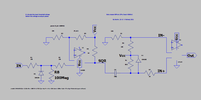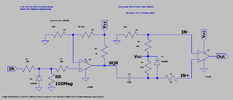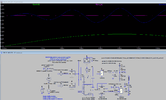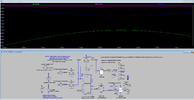K
KerimF
Guest
About 6 years ago, I started this thread. I re-started it for the undergraduates and professors who are interested in the AM communications system.
I uploaded LTspice files. They simulate the simplest reliable analogue AM demodulator which works for all modulation indexes; from m=0 (no modulating signal) to infinity (no carrier).
Its PLL (just one loop, not two in quadrature as in Costas Loop) locks with the suppressed carrier (frequency and phase). So, it has a frequency lock range much like in FM receivers. Also, unlike the case of the Squaring Method, it doesn’t need any selective filter, passive or active.
As you will see, its circuit could be integrated in a relatively low-cost IC (for MW and SW bands, in the least). But since all IC manufacturers and the universities around the world have no idea of it, the DSB-SC system lost its importance with time. It happens that the two well-known topologies for a DSB-SC demodulator are not practical for the general use (you may like to see the actual FCC regulation about using DSB-SC system).
The disadvantage of DSB-SC system is that its channel bandwidth is twice of the SSB one. But, on the other hand, its modulator is simpler than of a SSB-SC one (mainly about filters). And, it has the best power efficiency, no voice gives no RF output. In fact, this second feature lets it likely be the best choice for the aviation RF communications near the crowded airports. It minimizes automatically the interferences which could be produced by several transmitters working on the same channel in the same period of time; for example, a pilot just needs to stop talking to turn off its RF signal completely and automatically while listening to someone else talking on the same channel.
Anyway, I guess it is too late now for the world to go back and take advantage of the DSB-SC system. I mean; the innovative topology of the versatile AM demodulator (carrier suppressed or not) here became just a new academic idea, now. It just proves that “demodulating a DSB-SC signal is much easier and more reliable than demodulating a SSB-SC one (mainly for radio amateurs). In other words, it proves the inverse of what it is believed and taught in all universities actually.
Based on the human logic, I believed, before I started my MS thesis in year 1979, that getting more coherent data (as the two symmetrical sidebands in DSB-SC) has to make life easier than getting less data (as the one sideband only in SSB-SC).
Cheers
Kerim
Please note:
[1] On my laptop, the various LTspice traces start to show up about 75 sec (100us real time) after running the simulation. For this reason and to those who don’t have LTspice, I also included 4 images in the attached zip file.
[2] The demodulator which I used in my private short-range RF links (in the 80’s), didn’t have the blocks X2, X4 and U2 (on the actual schematic). And it worked fine for several years.
[3] After installing the LTspice simulator, I had the idea to make it better in case an IC manufacturer may like its topology to patent it and produce a new family of ICs (likely for SW radio amateurs who can get a license in using the DSB-SC system).
I uploaded LTspice files. They simulate the simplest reliable analogue AM demodulator which works for all modulation indexes; from m=0 (no modulating signal) to infinity (no carrier).
Its PLL (just one loop, not two in quadrature as in Costas Loop) locks with the suppressed carrier (frequency and phase). So, it has a frequency lock range much like in FM receivers. Also, unlike the case of the Squaring Method, it doesn’t need any selective filter, passive or active.
As you will see, its circuit could be integrated in a relatively low-cost IC (for MW and SW bands, in the least). But since all IC manufacturers and the universities around the world have no idea of it, the DSB-SC system lost its importance with time. It happens that the two well-known topologies for a DSB-SC demodulator are not practical for the general use (you may like to see the actual FCC regulation about using DSB-SC system).
The disadvantage of DSB-SC system is that its channel bandwidth is twice of the SSB one. But, on the other hand, its modulator is simpler than of a SSB-SC one (mainly about filters). And, it has the best power efficiency, no voice gives no RF output. In fact, this second feature lets it likely be the best choice for the aviation RF communications near the crowded airports. It minimizes automatically the interferences which could be produced by several transmitters working on the same channel in the same period of time; for example, a pilot just needs to stop talking to turn off its RF signal completely and automatically while listening to someone else talking on the same channel.
Anyway, I guess it is too late now for the world to go back and take advantage of the DSB-SC system. I mean; the innovative topology of the versatile AM demodulator (carrier suppressed or not) here became just a new academic idea, now. It just proves that “demodulating a DSB-SC signal is much easier and more reliable than demodulating a SSB-SC one (mainly for radio amateurs). In other words, it proves the inverse of what it is believed and taught in all universities actually.
Based on the human logic, I believed, before I started my MS thesis in year 1979, that getting more coherent data (as the two symmetrical sidebands in DSB-SC) has to make life easier than getting less data (as the one sideband only in SSB-SC).
Cheers
Kerim
Please note:
[1] On my laptop, the various LTspice traces start to show up about 75 sec (100us real time) after running the simulation. For this reason and to those who don’t have LTspice, I also included 4 images in the attached zip file.
[2] The demodulator which I used in my private short-range RF links (in the 80’s), didn’t have the blocks X2, X4 and U2 (on the actual schematic). And it worked fine for several years.
[3] After installing the LTspice simulator, I had the idea to make it better in case an IC manufacturer may like its topology to patent it and produce a new family of ICs (likely for SW radio amateurs who can get a license in using the DSB-SC system).






